はじめによ
んでください
変形文法入門
Transformational
grammer
池田光穂
変形文法とは「文法記述に変形操作を不可
欠なものとして含む文法の意。変形の考えは,Z.ハリス(Zellig Sabbetai
Harris)が早く提唱しているが,特に断らないかぎり,一般に変形文法といって N.チョムスキーによって提唱された「変形生成文法
(transformational-generative
grammar, TGG/ transformational grammar, TG)」をさす。自然言語に内在する規則性を規
定するためには,文の表層構造だけの記述では不十分で,基本的な文法関係を指定する抽象的な深層
構造,およびその両者を結びつけるための変形規則が必要であるとする文法論。変形は,たとえば平叙文と質問文,能動文と受動文との間にみられる構造上の関
係を,共通の基底記号列から導く役割をもつもので,構造記述と構造変化によって定義される構造依存的な性質をもっている。変形はまた変換とも呼ばれる」ブリタニカ)
"In linguistics,
transformational grammar (TG) or transformational-generative grammar
(TGG) is part of the theory of generative grammar, especially of
natural languages. It considers grammar to be a system of rules that
generate exactly those combinations of words that form grammatical
sentences in a given language and involves the use of defined
operations (called transformations) to produce new sentences from
existing ones. The method is commonly associated with American linguist
Noam Chomsky. Transformational algebra was first introduced to general
linguistics by the structural linguist Louis Hjelmslev.[1] A
modification which separated discourse and semantics from syntax was
subsequently made by Zellig Harris, giving rise to what became known as
transformational generative grammar.[1] The full Hjelmslevian
conception, in contrast, is incorporated into functional grammar.[2]"-
Ttransformational grammar (TG) or transformational-generative grammar
(TGG
|
言語学において、変形文法(TG)または変形生成文法(TGG)は、特
に自然言語の生成文法の理論の一部である。文法とは、与えられた言語において文法的な文を形成する単語の組み合わせを正確に生成するルールの体系であると
考え、既存の文から新しい文を生成するために定義された操作(変換と呼ばれる)を使用する。この方法は一般的にアメリカの言語学者ノーム・チョムスキーに
関連している。変換代数は構造言語学者ルイス・ヒェルムスレフによって初めて一般言語学に導入された。その後、ゼリグ・ハリスによって談話と意味論を統語
論から分離する修正が加えられ、変形生成文法として知られるようになった。これとは対照的に、ヘルムスレフの完全な概念は機能文法に組み込まれている。-
Ttransformational
grammar (TG) or transformational-generative grammar (TGG) |
| "Generative
grammar is a concept in generative linguistics, a linguistic
theory
that regards linguistics as the study of a hypothesised innate
grammatical structure.[3] It is a biological[4] or biologistic[5]
modification of structuralist theories, deriving ultimately from
glossematics.[6][7][a] Generative Grammar considers grammar as a system
of rules that generates exactly those combinations of words that form
grammatical sentences in a given language. The difference from
structural and functional models is that the object is placed into the
verb phrase in generative grammar.[8][9] This purportedly cognitive
structure is thought of as being a part of a universal grammar, a
syntactic structure which is caused by a genetic mutation in
humans.[10]
Generativists have created numerous theories to make the NP VP (NP)
analysis work in natural language description. That is, the subject and
the verb phrase appearing as independent constituents, and the object
placed within the verb phrase. A main point of interest remains in how
to appropriately analyse Wh-movement and other cases where the subject
appears to separate the verb from the object.[11] Although claimed by
generativists as a cognitively real structure, neuroscience has found
no evidence for it.[12][13] In other words, generative grammar
encompasses proposed models of linguistic cognition; but as of yet
there is no specific indication that these are quite correct."- Generative
grammar. |
生成文法とは、生成言語学の概念であり、言語学を仮説に基づいた生得的
な文法構造の研究とみなす言語理論である。これは、構造主義理論を生物学的または生物学的に修正したものであり、最終的にはグローセマティックスに由来す
る。生成文法は、文法を、ある言語において文法的な文章を形成する単語の組み合わせを正確に生成する規則体系として考える。構造モデルや機能モデルとの違
いは、生成文法では目的語が動詞句の中に置かれることである。この認知的構造と称されるものは、普遍文法の一部であり、人間の遺伝子変異によって引き起こ
される統語構造であると考えられている。生成論者は、自然言語記述においてNP
VP(NP)分析を機能させるために、数多くの理論を作り上げてきた。つまり、主語と動詞句は独立した構成要素として現れ、目的語は動詞句の中に置かれ
る。Wh-movementなど、主語が動詞と目的語を分離しているように見えるケースをどのように適切に分析するかが大きな関心事として残っている。生
成論者は認知的に実在する構造であると主張しているが、神経科学的にはその証拠は見つかっていない。言い換えれば、生成文法は言語認知のモデルとして提案
されたものを包含しているが、今のところ、これらが完全に正しいという具体的な証拠はない。- Generative
grammar. |
文
|
Sentence, S
|
 |
構造
|
structure
|
|
名詞句
|
Noun Phrase, NP
|
|
| 動詞句 |
Verb Phrase, VP
|
|
動詞
|
Verb
|
|
前置詞句
|
Prepositional
Phrase, PP
|
|
前置詞
|
Preposition, P
|
 左の図は、句構造が、書きかえ規則により書きかえ可能になっている様子を記述しているものになっている 左の図は、句構造が、書きかえ規則により書きかえ可能になっている様子を記述しているものになっている |
句
構造規則
|
pharase sturucture rules
|
上掲の(19)で例示したような規則
|
書きかえ規則
|
rewriting rules
|
句構造規則は書きかえ規則の一種
i. A→B/ X_Y (AがXとYのあいだにあれば、Bに書き換えよ)
ii. A→B/ _Y (AがYの前にあれば、Bに書き換えよ)
iii. A→B/ X_ (AがXの後ろにあれば、Bに書き換えよ)
iv. A→B (Aを無条件にBに書き換えよ)
|
発端記号
|
initial symbol
|
|
終端記号
|
terminal symbols
|
|
非終端記号
|
nonterminal symbols
|
|
派生
|
derivative
|
|
終端記号列
|
terminal string
|
|
法助動詞
|
Modal auxiliary
|
p.29, pp.83-. 知的助動詞、心的助動詞
|
深
層構造
|
deep structure
|
p.32 句構造は深層構造を導きだす力がある
|
表
層構造
|
surface structure
|
ただし、深層構造から表層構造を導きだすためには、句構造規則は不適
格。深層構造から表層構造を導きだすためには《変形規則》を知る必要がある。 |
| 句
構造 |
pharase sturucture |
|
| 変形規則 |
transformational rules
|
意味構造は、変形部に送られ、変形規則によって表層構造に変えられる
(p.36-)
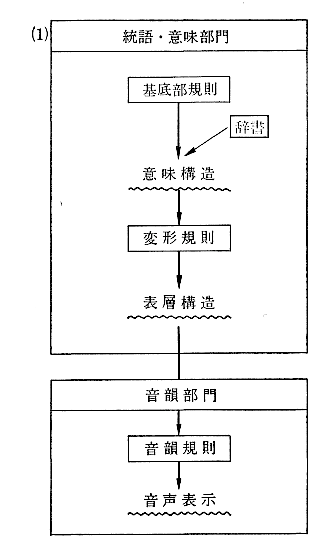
|
意味構造
|
semantic structure
|
|
統語・意味部門
|
sytactico-semantic component
|
|
音韻部門
|
phonological component
|
pp.56-.
|
基底部
|
base
|
|
変形部
|
transformational subcomponent
|
|
基底部規則
|
base rules
|
|
辞書
|
lexicon
|
|
音韻規則
|
phonological rules
|
|
音声表示
|
phonetic representation
|
|
副詞句
|
Adverbial phrase, Adv
|
|
代役記号
|
dummy symbol
|
p.42
|
辞書項目挿入
|
lexical insertion
|
|
素性指定
|
feature specification
|
|
範疇素性
|
categorical feature
|
|
本有的素性
|
inherent feature
|
p.47
|
厳密下位範疇化素性
|
strict subcategorization feature
|
|
選択素性
|
selectional feature
|
|
支配している
|
dominates
|
|
支配されている
|
dominated
|
|
親文
|
|
|
子文
|
|
|
節点
|
node
|
|
動詞句くりあげ
|
VP-Raising
|
p.50. 変形規則の一種.
PASTは、(過去時制の接辞ないしは、過去の動詞マーカー)p.62
 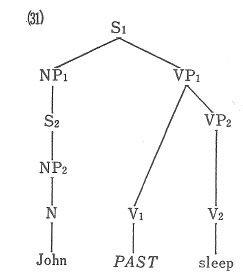 |
接辞規則
|
affix rule
|
|
構造記述
|
structural description
|
p.54.
|
受動態
|
|
John killed the bear.
の深層構造は John PAST kill the bear.
そして統辞規則のみがかかった場合は
John killed the bear.がうまれ、
統辞規則以前に、受動変形がかかった場合には、
The bear was killed by John.が、うまれる(p.210)
|
他動詞
|
transitive Verb, Vt
|
|
自動詞
|
intransitive Verb, Vi
|
|
状態受動態
|
passive of being
|
|
be-受動文
|
|
|
間接目的語移動
|
indirect object movement
|
p.215
|
(受動態化)
|
passivization
|
p.216
|
数量詞
|
quantifier
|
|
get-受動文
|
|
|
サイク移動
|
Psych movemnt
|
p.227
|
|
PAST
|
(過去時制の接辞ないしは、過去の動詞マーカー)p.62. 大文字は
語彙の機能を示していると思われる
|
|
PERS
|
(現在時制の接辞ないしは、現在の動詞マーカー)p.63 |
|
PROG
|
PROGressive,
(進行時制の接辞ないしは、進行の動詞マーカー) |
|
NOT
|
否定の接辞、ないしは、否定のマーカー
|
言語運用能力
|
linguistic competence
|
p.292
|
資料:変形文法入門のそのまた入門;imai_transformative_grammer1975.pdf;
(受動態)imai_TR_grammer_1975.pdf
リンク
文献
その他の情報
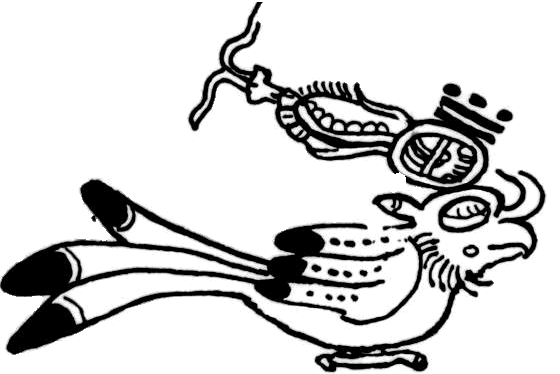 Copyleft,
CC, Mitzub'ixi Quq Chi'j, 1996-2099
Copyleft,
CC, Mitzub'ixi Quq Chi'j, 1996-2099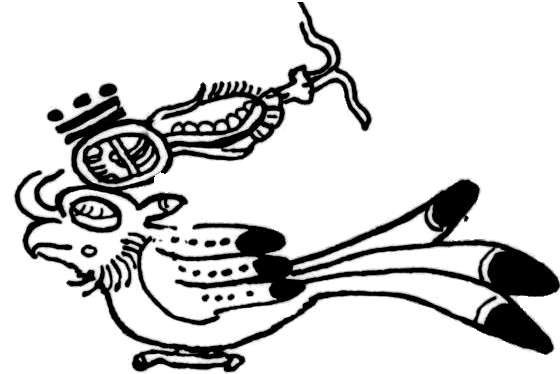
Do not paste, but [re]think this message for all undergraduate
students!!!
Copyleft,
CC, Mitzub'ixi Quq Chi'j, 1996-2099
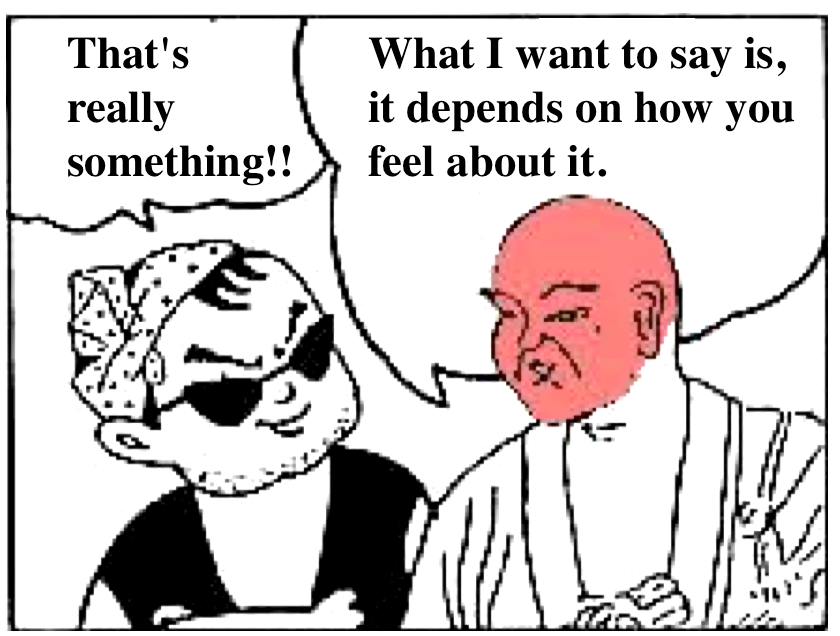
☆
 ☆
☆

 左の図は、句構造が、書きかえ規則により書きかえ可能になっている様子を記述しているものになっている
左の図は、句構造が、書きかえ規則により書きかえ可能になっている様子を記述しているものになっている


 Copyleft,
CC, Mitzub'ixi Quq Chi'j, 1996-2099
Copyleft,
CC, Mitzub'ixi Quq Chi'j, 1996-2099


 ☆
☆